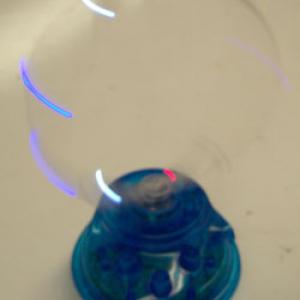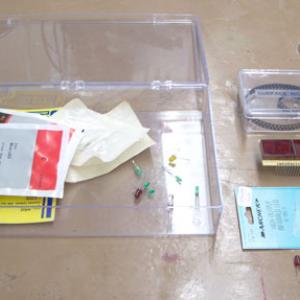College of Liberal Arts & Sciences
5M10.55 - LED's
The LED Rainbow may be used in a variety of ways. It is designed to show the turn on voltage of each color LED which is different for each color. You may use the genecon generator to show this but you will have to crank very fast to get the purple (UV) LED's to light. Using the power supply that can go from 0 to 12 volts will be easier, but you will see that the turn on voltages of the Red, Orange, and Yellow LED's are very close together. A very cool way to use this display is to use the PASCO function generator as the power source. Set the generator to a ramping voltage with a 0.18 Hz. frequency and maximum voltage (10 volts). NOTE: you will have to short across one of the purple (UV) LED's as the function generator is limited to 10 volts maximum output. This will allow the other 3 LED's in that section to light as the voltage ramps up.
Select the LED for the demonstration you wish to show. Many of our other demonstrations also use LED's in some form and are available for new LED demonstrations if needed.
- Jennifer J. Birriel, "Physics of Holiday Lights", TPT, Vol. 62, #2, Feb. 2024, p. 152.
- James Lincoln, What is a Pink Diode? Further Experiments With LED Technology, TPT, Vol. 58, #5, May 2020, p. 364.
- Gorazd Planinšič and Eugenia Etkina, "Light-Emitting Diodes: Solving Complex Problems", TPT, Vol. 53, #5, May 2015, p. 291.
- Gorazd Planinšič and Eugenia Etkina, "Light-Emitting Diodes: Learning New Physics", TPT, Vol. 53, #4, Apr. 2015, p. 210.
- Eugenia Etkina and Gorazd Planinšič, "Light-Emitting Diodes: Exploration of Underlying Physics", TPT, Vol. 52, #4, Apr. 2014, p. 212.
- Gorazd Planinšič and Eugenia Etkina, "Light-Emitting Diodes: A Hidden Treasure", TPT, Vol. 52, #2, Feb. 2014, p. 94.
- Jochen Kuhn and Patrik Vogt, "Diffraction Experiments with Infrared Remote Controls", TPT, Vol. 50, #2, Feb. 2012, p. 118.
- Leoš Dvořák, "A Do-It-Yourself Optical Bench", TPT, Vol. 49, #7, Oct. 2011, p. 452.
- James A. Einsporn and Andrew F. Zhou, "The 'Green Lab': Power Consumption by Commercial Light Bulbs", TPT, Vol. 49, #6, Sep. 2011, p. 365.
- William H. Baird, W. Nathan Hack, Kiet Tran, Zeeshan Vira, Mathew Pickett, "The Light-Emitting Diode as a Light Detector", TPT, Vol. 49, #3, March 2001, p. 171.
- Mickey Kutzner, Richard Wright, and Emily Kutzner, "An Inexpensive LED Light Sensor", TPT, Vol. 48, #5, May 2010, p. 341.
- T. Terzella, J. Sundermier, J. Sinacore, C. Owen, and H. Takai, "Measurement of g Using a Flashing LED", TPT, Vol. 46, #7, Oct. 2008, p. 395.
- Gordon McIntosh, "A Simple Photometer to Study Skylight", TPT, Vol. 44, #8, Nov. 2006, p. 540.
- Adolf Cortel, "Simple Photoelectric Effect", TPT, Vol. 44, #5, May 2006, p. 310.
- Wayne P. Garver, "The Photoelectric Effect Using LEDs as Light Sources", TPT, Vol. 44, #5, May 2006, p. 272.
- Se-yuen Mak, "A Multipurpose LED Light Source for Optics Experiments", TPT, Vol. 42, #9, Dec. 2004, p. 550.
- Gorazd Planinšič, "Color Mixer for Every Student", TPT, Vol. 42, #3, Mar. 2004, p. 138.
- E. Etkina, A. Van Heuvelen, D. T. Brookes, and D. Mills, "Role of Experiments in Physics Instruction - A Process Approach", TPT, Vol. 40, #6, Sept. 2002, p. 351.
- Adam Niculescu, "Demonstration of Light-Wave Communication for High School Physics", TPT, Vol. 40, #6, Sept. 2002, p. 347.
- Juan A. Pomarico, "Seeing Rectifiers at Work", TPT, Vol. 40, #2, Feb. 2002, p. 118.
- Charles A. Sawicki, "Easy and Inexpensive Demonstration of Light Interference", TPT, Vol. 39, #1, Jan. 2001, p. 16.
- Dan Lottis and Herbert Jaeger, "LED's in Physics Demos: A Handful of Examples", TPT, Vol. 34, #3, Mar. 1996, p. 144.
- John W. Jewett Jr., "Get the LED Out", TPT, Vol. 29, #8, Nov. 1991, p. 530.
- Lloyd Harrich, "AC Made Visible", TPT, Vol. 22, #7, Oct. 1984, p. 448.
- Yaakov Kraftmakher, "Experiments with Light-Emitting Diodes", AJP, Vol. 79, #8, Aug. 2011, p. 825.
- N. Holonyak Jr., "Is the Light Emitting Diode (LED) an Ultimate Lamp?", AJP, Vol. 68, #9, Sep. 2000, p. 864.
- E. Redondo, A. Ojeda, G. Gonzalez Diaz, I. Martil, "A Laboratory Experiment With Blue Light-Emitting Diodes", AJP, Vol. 65, #5, May 1997, p. 371.
- David A. Johnson, "Demonstrating the Light-Emitting Diode", AJP, Vol. 63, #8, Aug. 1995, p. 761.
- Goerge T. Gillies, "Altered Light-Emitting Diode Point Source Emitter", AJP, Vol. 48, #5, May 1980, p. 418.
- John B. Kwasnoski, "A Laboratory Investigation of Light-Emitting Diodes", AJP, Vol. 40, #4, April 1972, p. 588.
- Vikrant Kumar, Keith Behrman, Ioannis Kymissis, "Putting MicroLED Technology on Display", Physics Today, Vol. 77, #6, June 2024, p. 30.
- Kevin Dowling, "LED Luminaries-A Whole New Light", Physics Today, Vol. 61, #3, Mar. 2008, p. 74.
- Arpad Bergh, George Craford, Anil Duggal, and Roland Haitz, "The Promise and Challenge of Solid-State Lighting", Physics Today, Vol. 54, #12, Dec. 2001, p. 42.
- Barun RayChaudhuri, "On the Determination of the Emission Wavelength of an Infrared LED with Common Laboratory Instruments", European Journal of Physics, Vol. 32, #4, July 2011, p. 935.
- A. M. Ojeda, E. Redondo, G. González Díaz, and I. Mártil, "Analysis of Light-Emission Processes in Light-Emitting Diodes and Semiconductor Lasers", European Journal of Physics, Vol. 18, #2, Mar. 1997, p. 63.
- Robert F. Service, "Perovskite LEDs Begin to Shine", Science, Vol. 364, #6444, June 2019, p. 918.
- Dawei Di, Alexander S. Romanov, Le Yang, Johannes M. Richter, Jasmine P. H. Rivett, Saul Jones, Tudor H. Thomas, Mojtaba Abdi Jalebi, Richard H. Friend, Mikko Linnolahti, Manfred Bochmann, and Dan Credgington, "High-Performance Light-Emitting Diodes Based on Carbene-Metal-Amides", Science, Vol. 356, #6334, Apr. 2017, p. 159.
- Dennis Normile, "Physicists Change the Light Bulb", Science, Vol. 346, #6206, Oct. 2014, p. 149.
- Alissa Zhu, "How LEDs Are Going To Replace Our Lights", Popular Science, Vol. 287, #1, Jan. 2015, p. 36.
- Theodore Gray, "Gray Matter: DIY LEDs", Popular Science, Vol. 282, #3, Mar. 2010, p. 70.
- Jonathan Hare, "A Simple Demonstration for Exploring the Radio Waves Generated by a Mobile Phone", Physics Education, Vol. 45, #5, Sept. 2010, p. 481.
- Jonathan Hare, "LED Demonstrates Piezoelectricity", Physics Education, Vol. 41, #3, May 2006, p. 212.
- Stanley J. Micklavzina, "Tricks with Invisible Light", Physics Education, Vol. 38, #6, Nov. 2003, p. 492.
- Daniel J. Swartling and Charlotte Morgan, "Lemon Cells Revisited - The Lemon-Powered Calculator", Journal of Chemical Education, Vol. 75, #2, Feb 1998, p. 181.
- Dennis Normile, "The Birth of the Blues", Science Supplement How it Works, Spring 2001, p. 176.
- Arthur B. Ellis et al, Teaching General Chemistry - A Materials Science Companion, p. 10.
- T. D. Rossing and C. S. Chiaveriue, "6.8, Light-Emitting Diodes", Light Science Physics and The Visual Arts", p. 140.
- Nikolay Zheludev, "The Life and Times of the LED - A 100-year History", Nature Photonics, Apr. 2007, p. 189.
- Kansas State University, "Light Emitting Diodes", Visual Quantum Mechanics The Next Generation", 2001.
- Kansas State University, "The Great White LED", Visual Quantum Mechanics The Next Generation", 2000.
- Robert Ehrlich, "9.3, Induced Currents Using LED's", Why Toast Lands Jelly-Side Down", p. 149.
- Earl R. Feltyberger et al., "Photon Emission by Light-Emitting Diodes (LED's), Teaching About D. C. Electric Circuits, p. 2.6.
- "How Do you Dim an LED?", The Caliper, Spring 2008, p. 9.
- Leos Dvorak and Gorazd Planninsic, "LED's in Water: Hands-on Electric Field Lines and Electric Potential".
- E. Etkina and A. Van Heuvelen, "Investigative Science Learning Environment - A Science Process Approach to Learning Physics".
- Physics Education Research Group, "LED Spectroscopy Lab", Kansas State University, https://web.phys.ksu.edu/vqm/software/online/vqm/
Disclaimer: These demonstrations are provided only for illustrative use by persons affiliated with The University of Iowa and only under the direction of a trained instructor or physicist. The University of Iowa is not responsible for demonstrations performed by those using their own equipment or who choose to use this reference material for their own purpose. The demonstrations included here are within the public domain and can be found in materials contained in libraries, bookstores, and through electronic sources. Performing all or any portion of any of these demonstrations, with or without revisions not depicted here entails inherent risks. These risks include, without limitation, bodily injury (and possibly death), including risks to health that may be temporary or permanent and that may exacerbate a pre-existing medical condition; and property loss or damage. Anyone performing any part of these demonstrations, even with revisions, knowingly and voluntarily assumes all risks associated with them.



